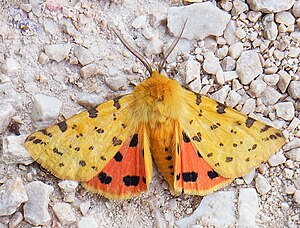Purple bear
| Purple bear | ||||||||||||
|---|---|---|---|---|---|---|---|---|---|---|---|---|

Purple bear ( Diacrisia purpurata ) |
||||||||||||
| Systematics | ||||||||||||
|
||||||||||||
| Scientific name | ||||||||||||
| Diacrisia purpurata | ||||||||||||
| ( Linnaeus , 1758) |
The purple bear or gooseberry bear ( Diacrisia purpurata , syn .: Rhyparia purpurata ) is a moth from the subfamily of the bear moth (Arctiinae).
features
The moths reach a wingspan of 40 to 50 millimeters. The forewings are golden yellow and have black spots that are not completely covering, so that the golden color shows through. Their hind wings are red, less often yellow, and have black spots. Her body is also golden yellow and black dots run backwards on her back. They are furry around their heads.
Occurrence
The purple bear is found all over Europe , with the exception of the far north, the western Atlantic coast and parts of the Mediterranean area . The species prefers habitats with higher vegetation, but occurs in both humid and dry locations. It inhabits wet meadows, raised and fens as well as semi-arid lawns, sandy fields, abandoned vineyards, heaths and forest clearings.
Way of life
The moths are nocturnal and fly in one generation from June to July. They often don't appear until after midnight and are then attracted by artificial light sources. Occasionally, however, they can also be found during the day, as they are easily recognizable by their conspicuous color and are easy to startle.
development
The females lay the eggs in fairly large, single-layer clutches of around 100 eggs. The hatching caterpillars overwinter and pupate only in May or June of the next year.
food
The caterpillars feed on various herbaceous plants, shrubs and shrubs, such as B. clover , Esparsette , broom , sloe , bedstraw , raspberry , thistle or heather . You always sit very high on the plants.
swell
- ↑ K. Rönka, J. Mappes, L. Kaila, N. Wahlberg: Putting Parasemia in its phylogenetic place: a molecular analysis of the subtribe Arctiina (Lepidoptera) . In: Systematic Entomology . tape 41 , 2016, p. 844-853 , doi : 10.1111 / syen.12194 .
- ^ A b Axel Steiner, Ulrich Ratzel, Morten Top-Jensen, Michael Fibiger: Die Nachtfalter Deutschlands . Bugbook Publishing, 2014, ISBN 978-3-00-043862-2 , pp. 400 .
- ↑ a b Heiko Bellmann : The new Kosmos butterfly guide. Butterflies, caterpillars and forage plants. 2nd Edition. Franckh-Kosmos, Stuttgart 2009, ISBN 978-3-440-11965-5 , p. 310.
literature
- Hans-Josef Weidemann, Jochen Köhler: Moths. Weirdos and hawkers. Naturbuch-Verlag, Augsburg 1996, ISBN 3-89440-128-1 .
Web links
- Rhyparia purpurata in Fauna Europaea

